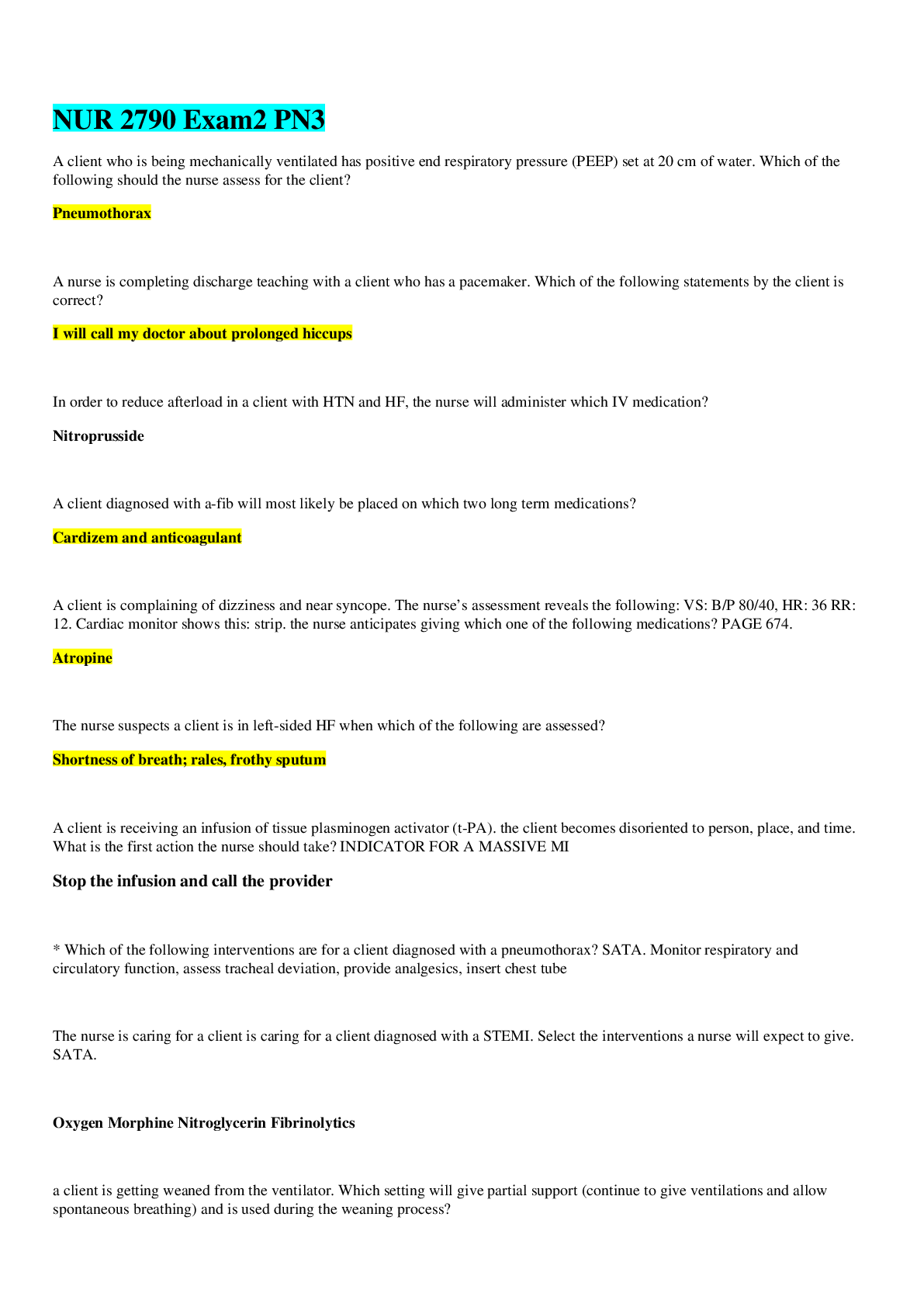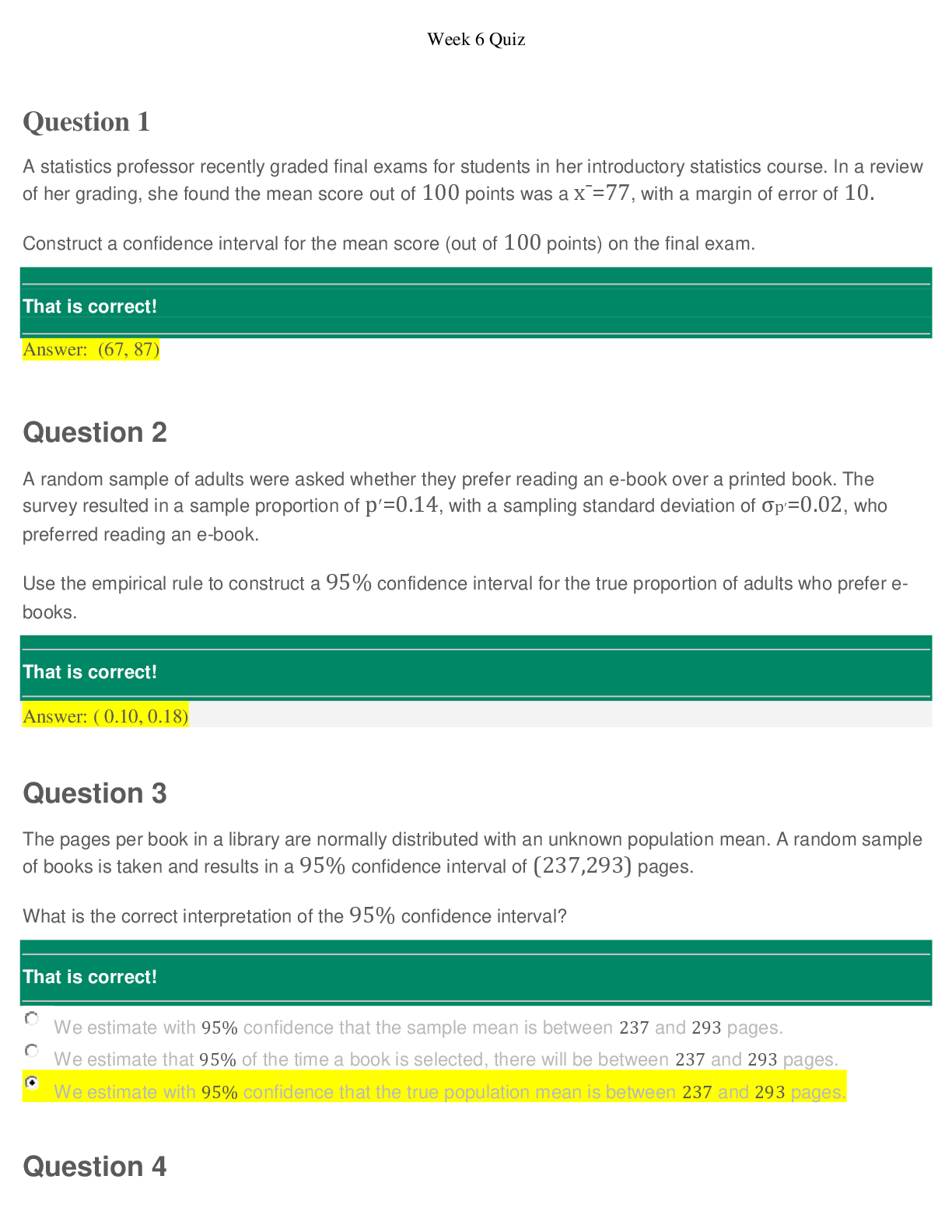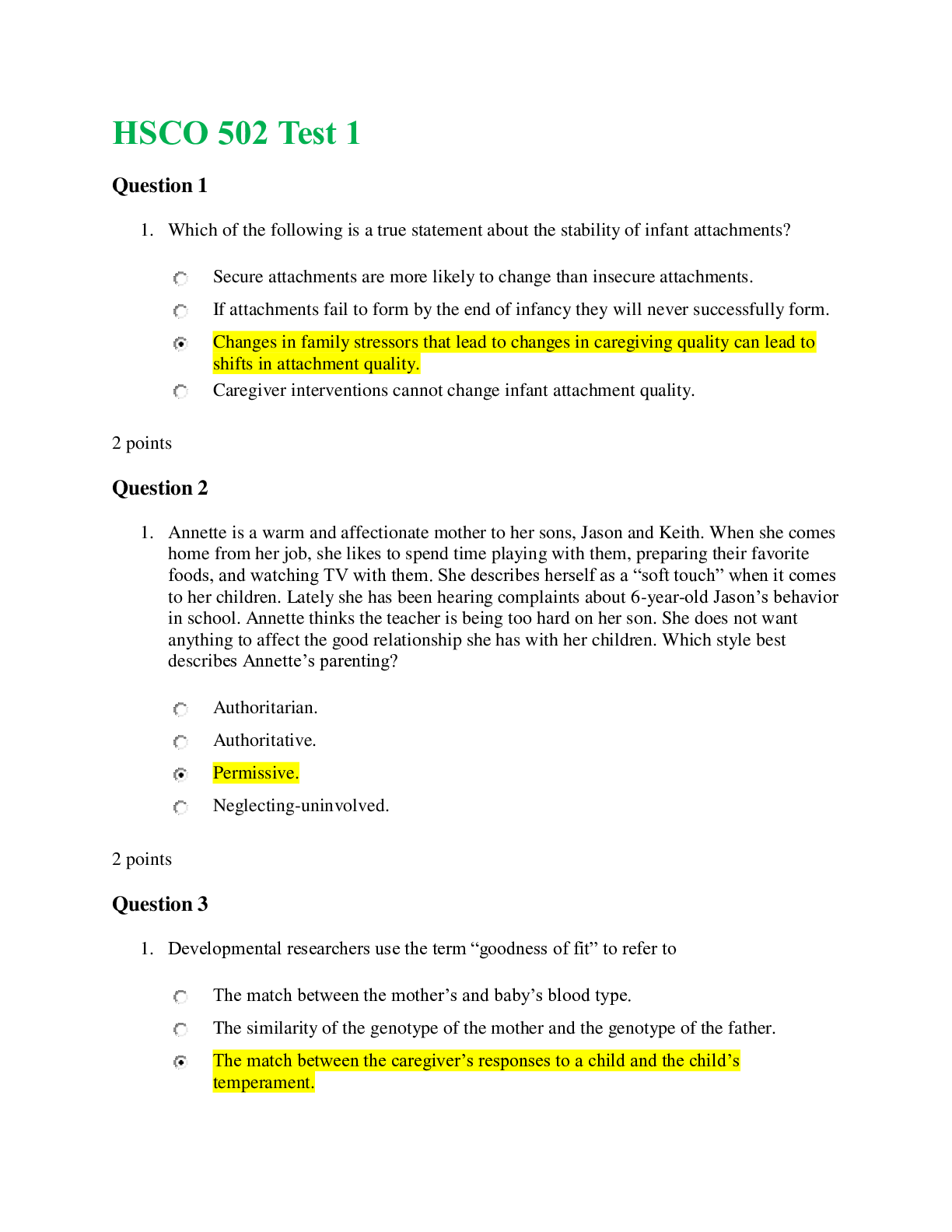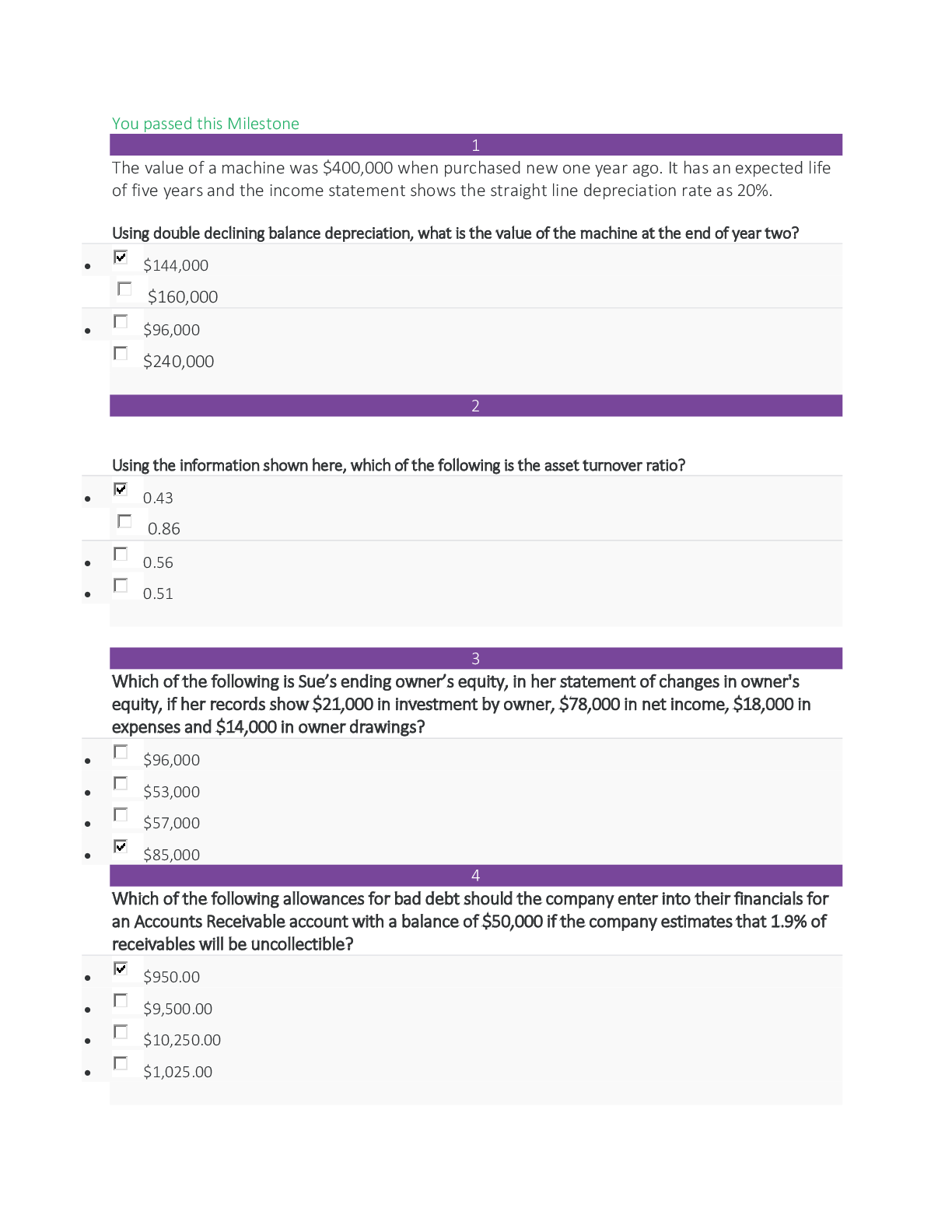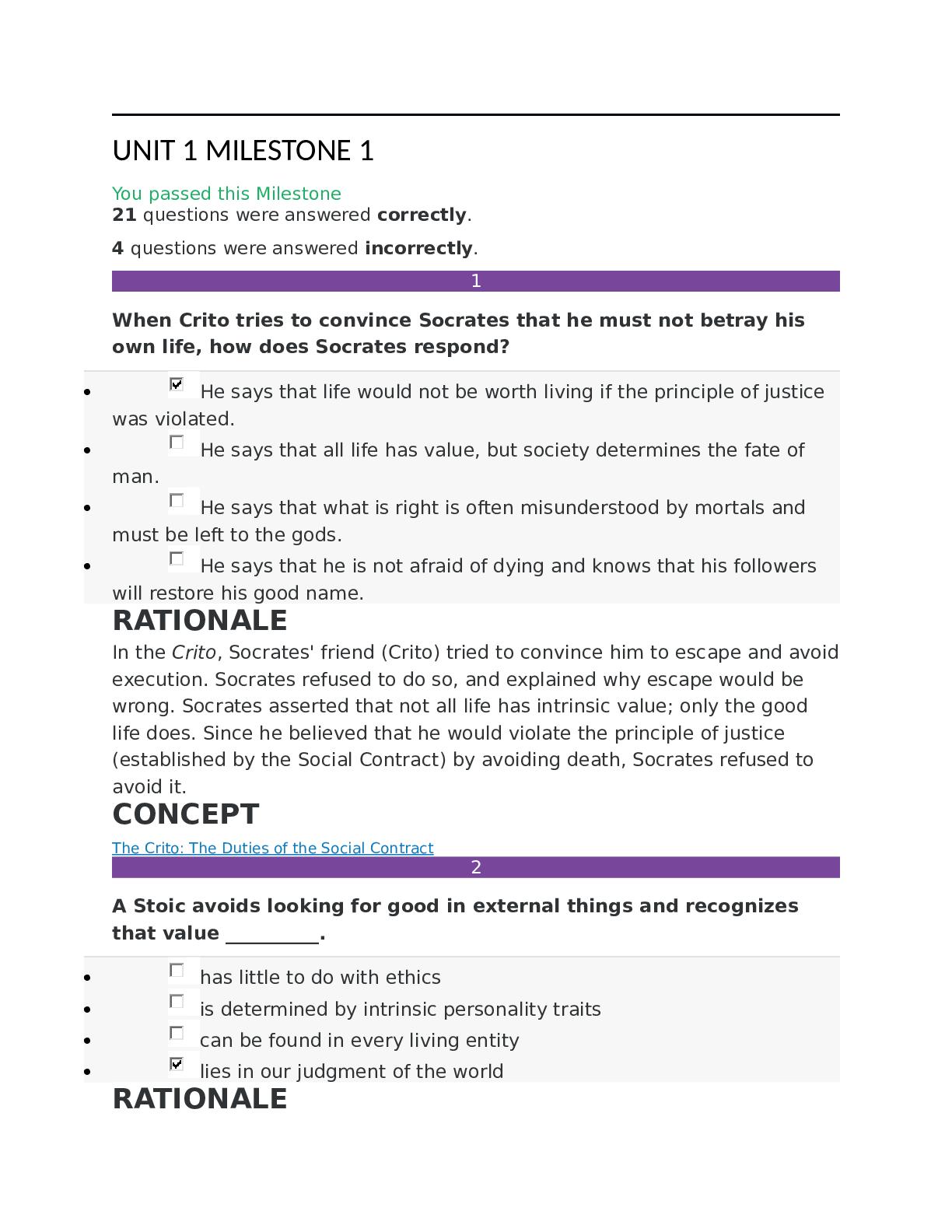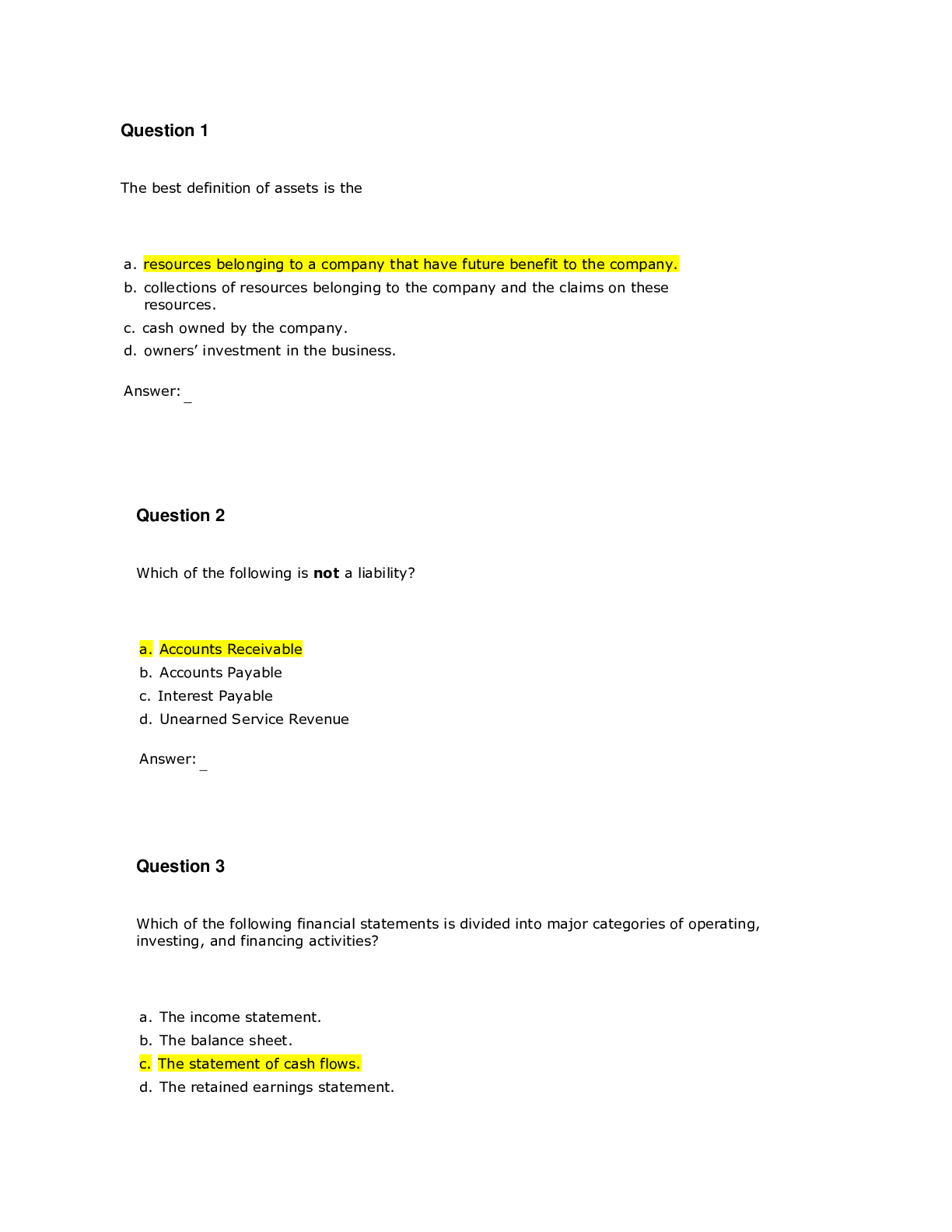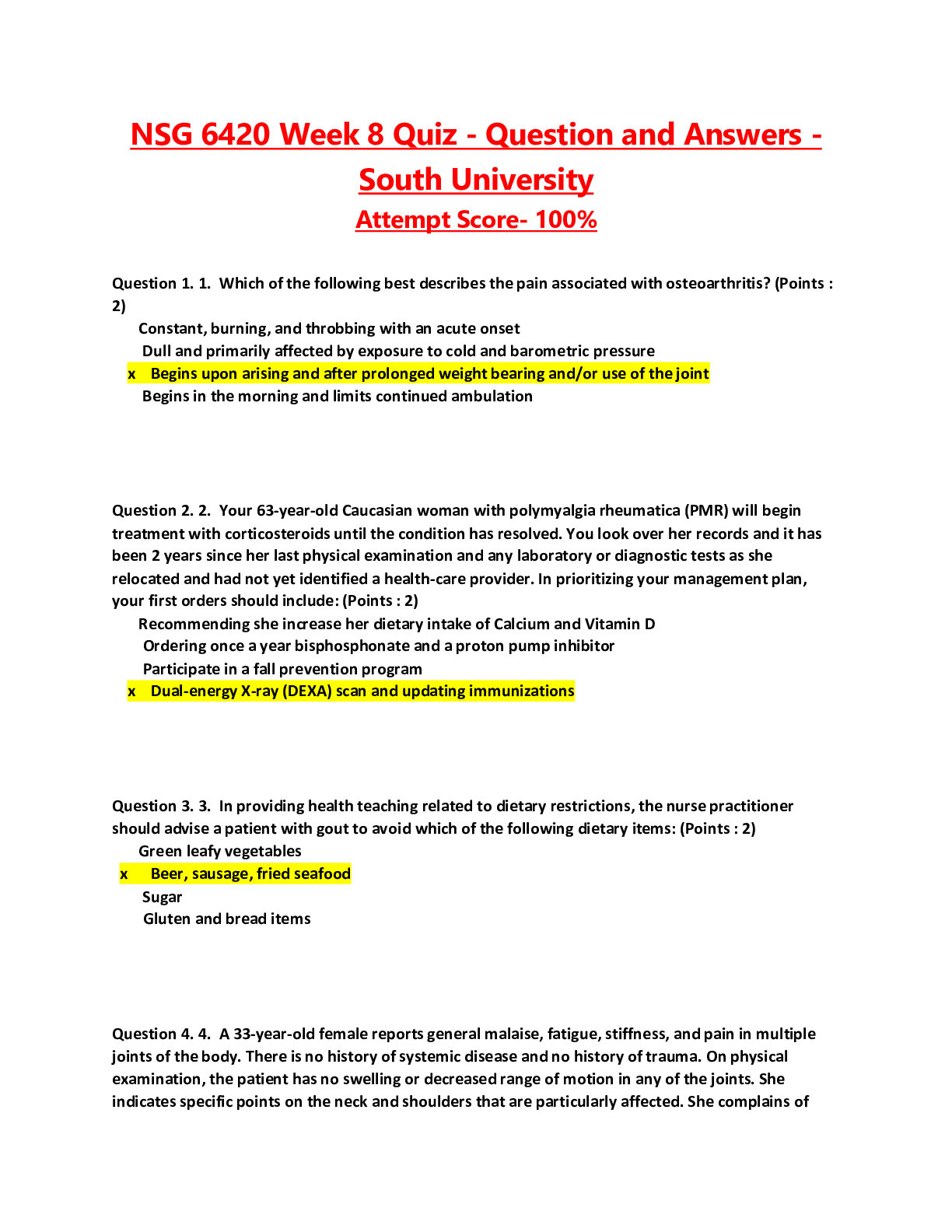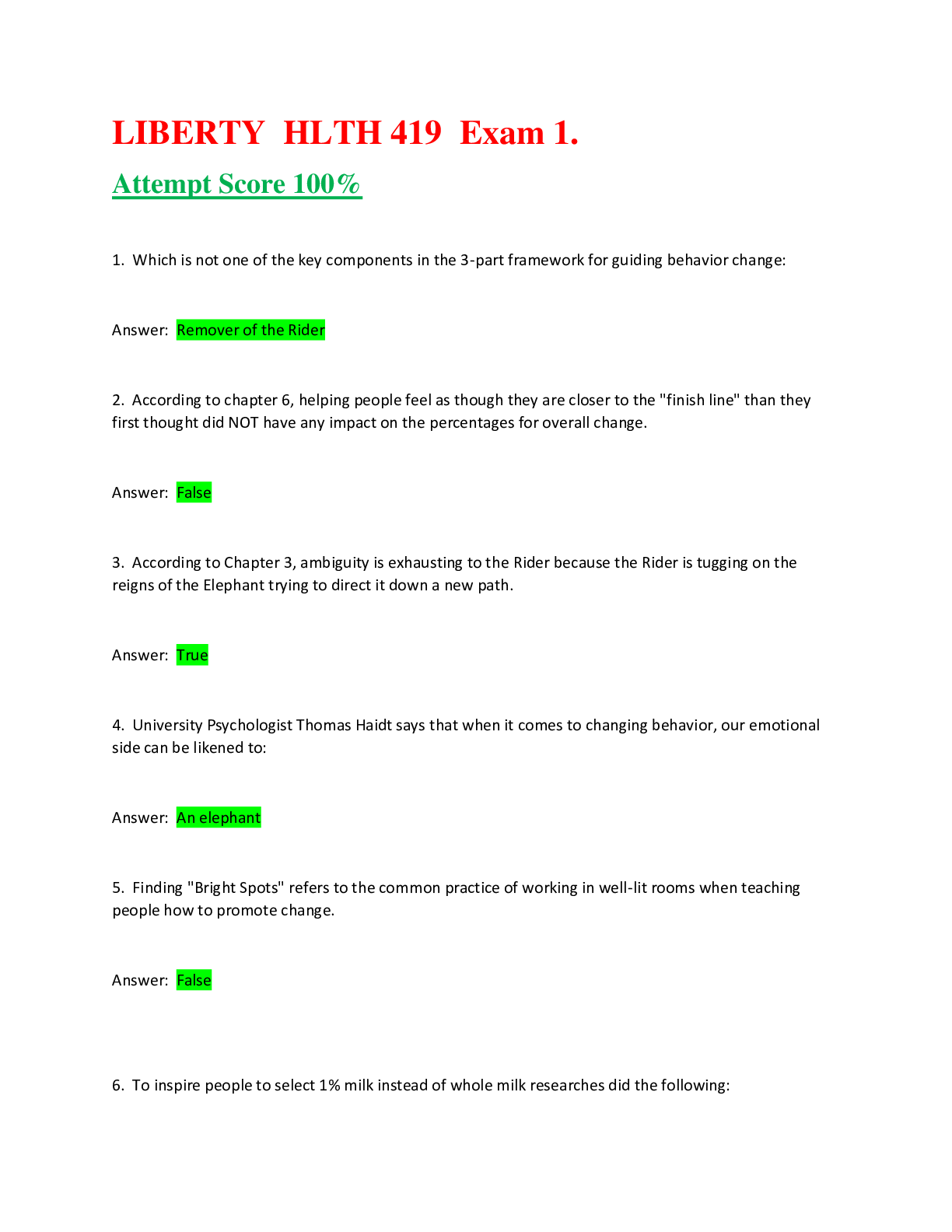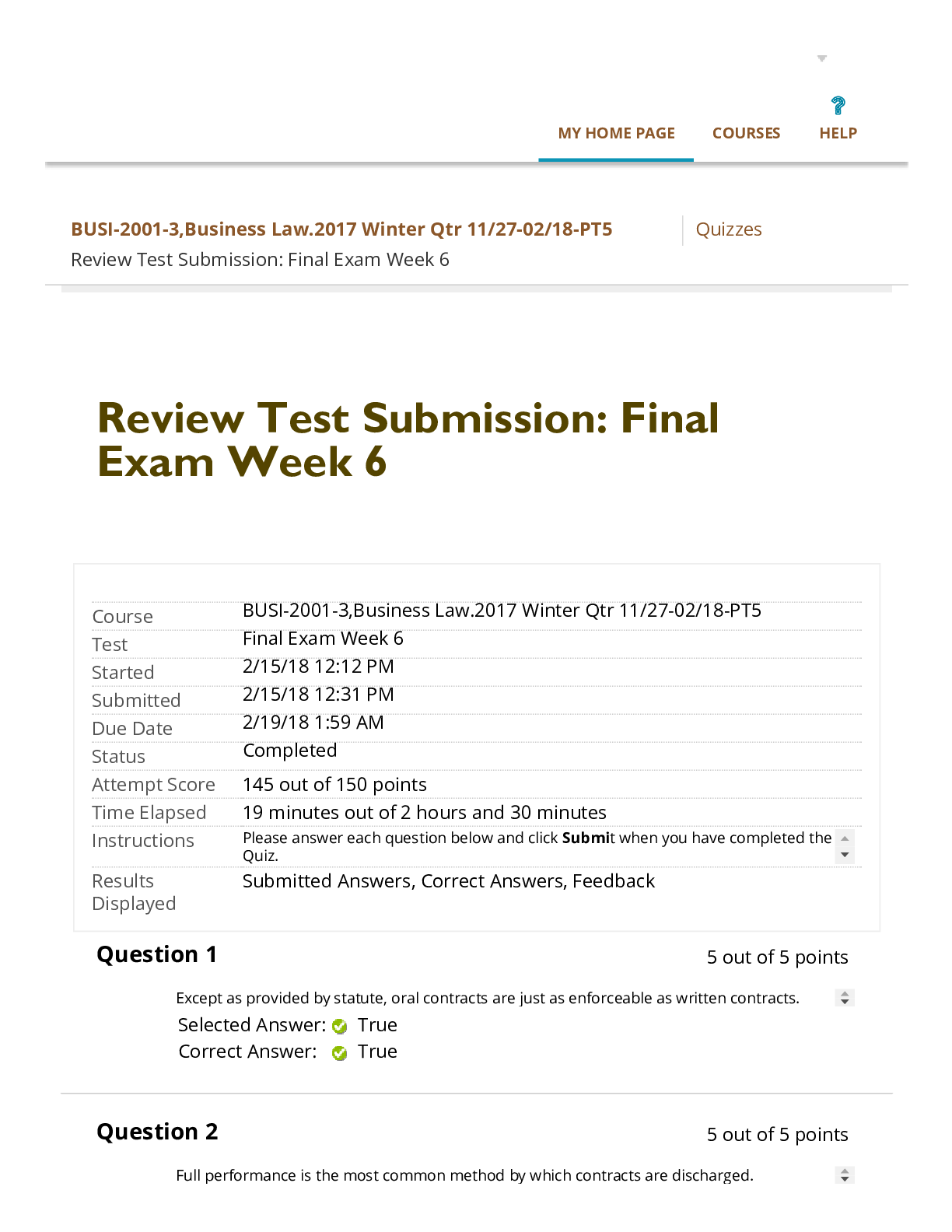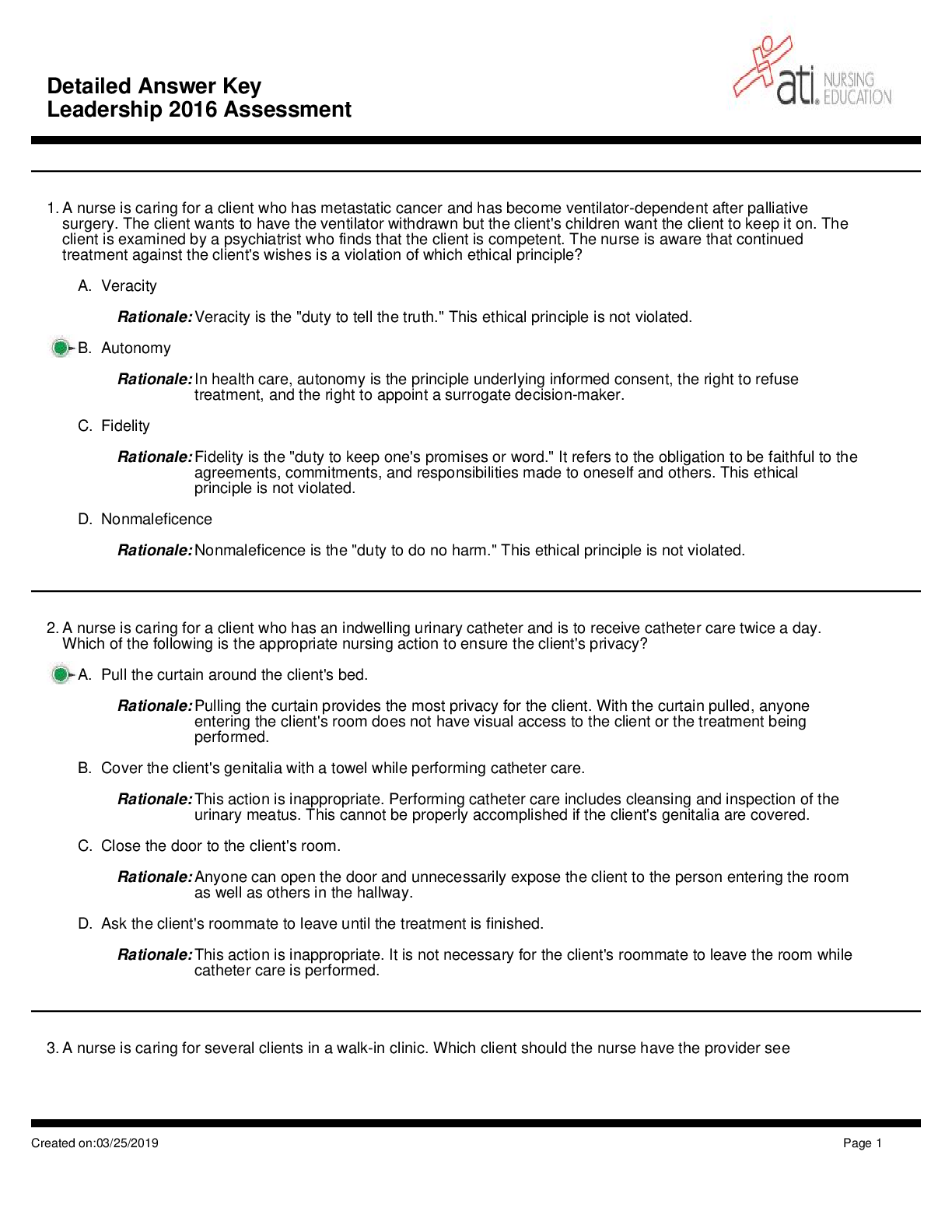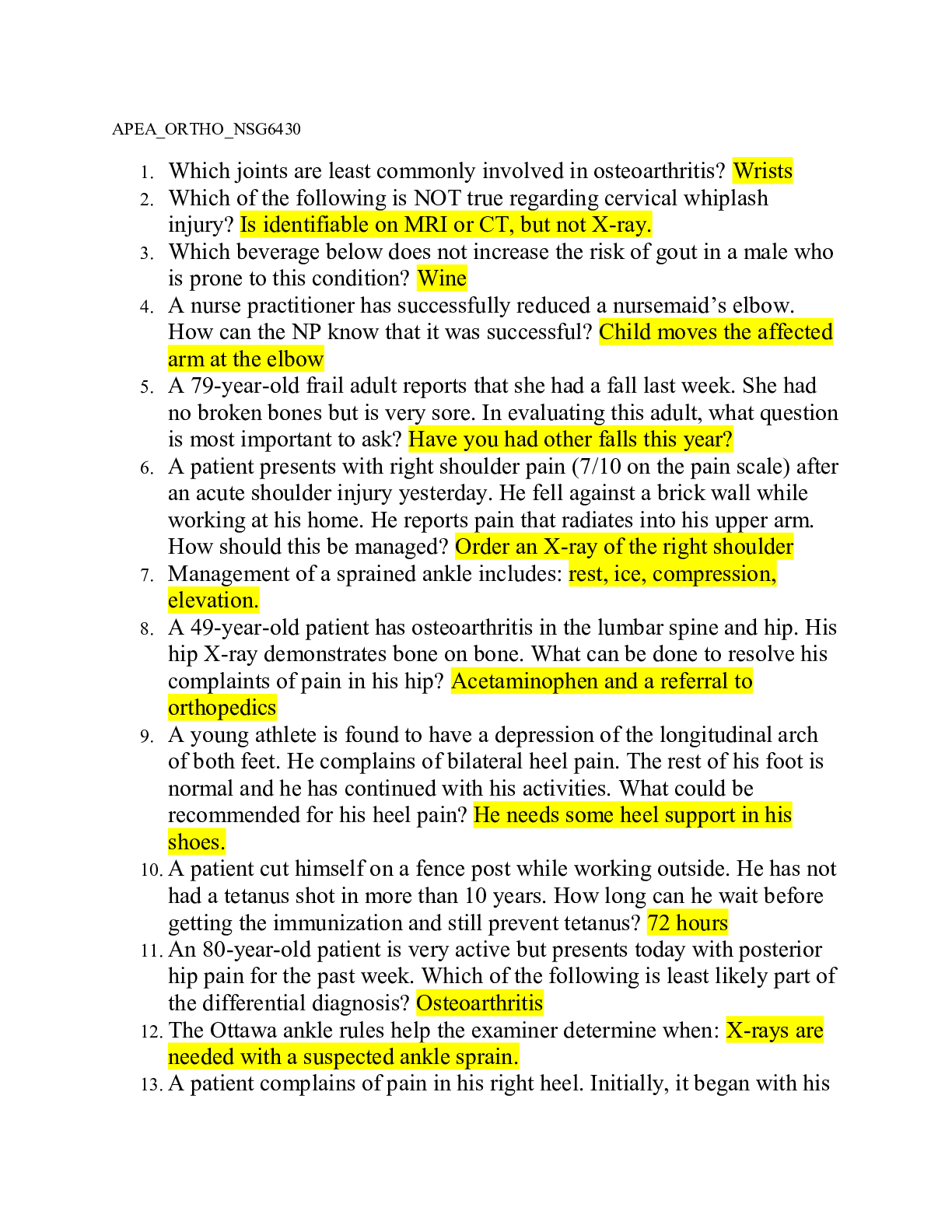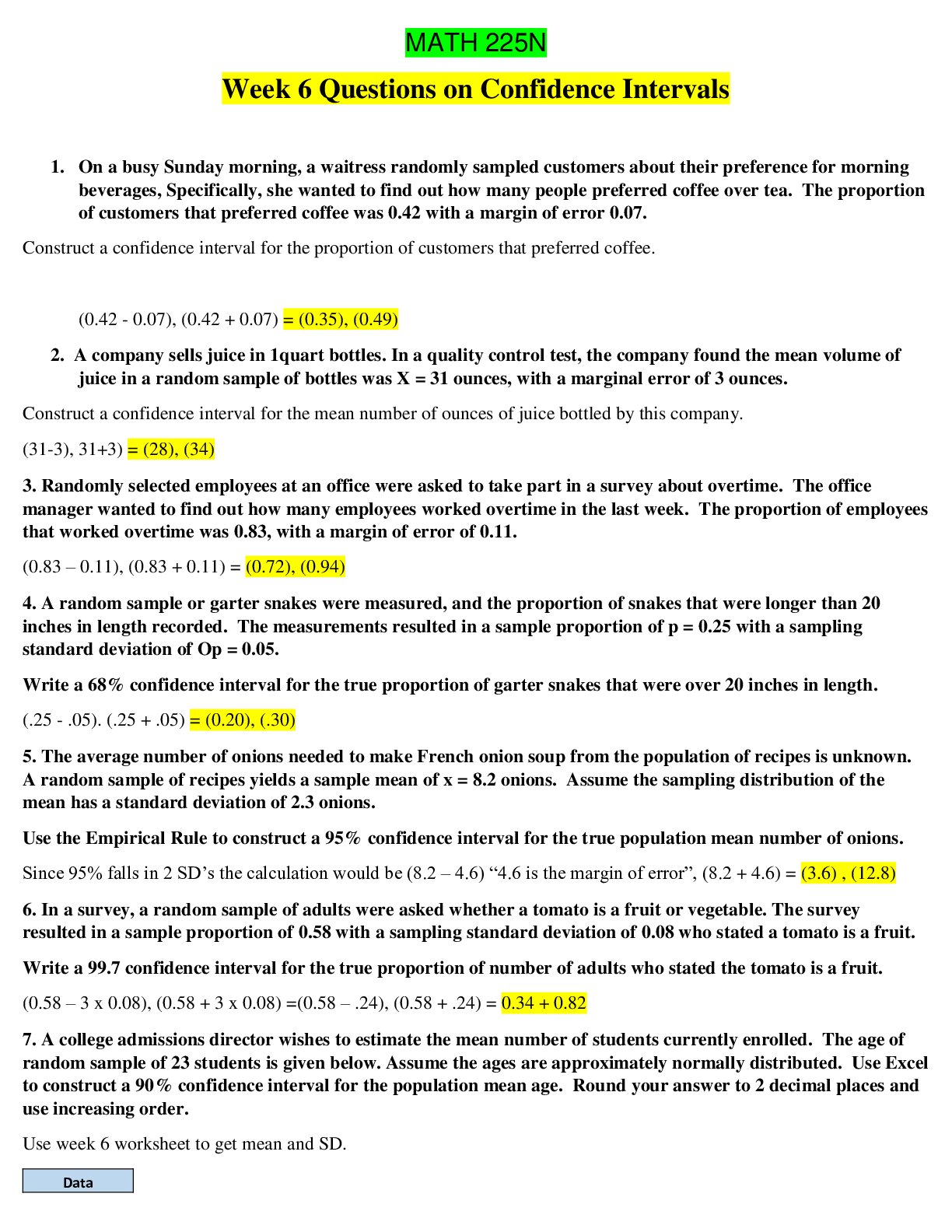*NURSING > EXAM > NURSING 250 > Muscle Saunders Questions & Answers - Latest guide (2019/20). Verified Answers,A+ (All)
NURSING 250 > Muscle Saunders Questions & Answers - Latest guide (2019/20). Verified Answers,A+
Document Content and Description Below
NURSING 250 muscle Saunders questions & Answers 1. The nurse is conducting health screening for osteoporosis. Which client is at greatest risk of developing this disorder? 2. The nurse has given in... structions to a client returning home after knee arthroscopy. Which statement by the client indicates that the instructions are understood? 3. The nurse witnessed a vehicle hit a pedestrian. The victim is dazed and tries to get up. A leg appears fractured. Which intervention should the nurse take? 4. Which cast care instructions should the nurse provide to a client who just had a plaster cast applied to the right forearm? Select all that apply. 5. The nurse is evaluating a client in skeletal traction. When evaluating the pin sites, the nurse would be most concerned with which finding? 6. The nurse is assessing the casted extremity of a client. Which sign is indicative of infection? 7. A client has sustained a closed fracture and has just had a cast applied to the affected arm. The client is complaining of intense pain. The nurse elevates the limb, applies an ice bag, and administers an analgesic, with little relief. Which problem may be causing this pain? 8. The nurse is admitting a client with multiple trauma injuries to the nursing unit. The client has a leg fracture and had a plaster cast applied. Which position would be best for the casted leg? 9. A client is being discharged to home after application of a plaster leg cast. Which statement indicates that the client understands proper care of the cast? 10. A client being measured for crutches asks the nurse why the crutches cannot rest up underneath the arm for extra support. The nurse responds knowing that which would most likelyresult from this improper crutch measurement? 11. The nurse has given the client instructions about crutch safety. Which statement indicates that the client understands the instructions? Select all that apply. 12. The nurse is caring for a client being treated for fat embolus after multiple fractures. Which data would the nurse evaluate as the most favorable indication of resolution of the fat embolus? 13. The nurse has conducted teaching with a client in an arm cast about the signs and symptoms of compartment syndrome. The nurse determines that the client understands the information if the client states that he or she should report which early symptom of compartment syndrome? 14. A client with diabetes mellitus has had a right below-knee amputation. Given the client's history of diabetes mellitus, which complication is the client at most risk for after surgery? 15. The nurse is caring for a client who had an above-knee amputation 2 days ago. The residual limb was wrapped with an elastic compression bandage, which has come off. Which immediateaction should the nurse take? 16. A client is complaining of low back pain that radiates down the left posterior thigh. The nurse should ask the client if the pain is worsened or aggravated by which factor? 17. The nurse is caring for a client who has had spinal fusion, with insertion of hardware. The nurse would be most concerned with which assessment finding? 18. The nurse is caring for a client with a diagnosis of gout. Which laboratory value would the nurse expect to note in the client? 19. A client with a hip fracture asks the nurse about Buck's (extension) traction that is being applied before surgery and what is involved. The nurse should provide which information to the client? 20. A client has been on treatment for rheumatoid arthritis for 3 weeks. During the administration of etanercept, which is most important for the nurse to assess? 21. Allopurinol is prescribed for a client and the nurse provides medication instructions to the client. Which instruction should the nurse provide? 22. Colchicine is prescribed for a client with a diagnosis of gout. The nurse reviews the client's record, knowing that this medication would be used with caution in which disorder? 23. Alendronate is prescribed for a client with osteoporosis and the nurse is providing instructions on administration of the medication. Which instruction should the nurse provide? 24. The nurse is preparing discharge instructions for a client receiving baclofen. Which instruction should be included in the teaching plan? 25. The nurse is analyzing the laboratory studies on a client receiving dantrolene. Which laboratory test would identify an adverse effect associated with the administration of this medication? 26. Cyclobenzaprine is prescribed for a client for muscle spasms and the nurse is reviewing the client's record. Which disorder, if noted in the record, would indicate a need to contact the health care provider about the administration of this medication? 27. In monitoring a client's response to disease-modifying antirheumatic drugs (DMARDs), which assessment findings would the nurse consider acceptable responses? Select all that apply. 28. The nurse is administering an intravenous dose of methocarbamol to a client with multiple sclerosis. For which adverse effect should the nurse monitor? 29. The nurse is assigned to care for a client in traction. The nurse creates a plan of care for the client and should include which action in the plan? 30. The nurse is caring for an older adult who has been placed in Buck's extension traction after a hip fracture. On assessment of the client, the nurse notes that the client is disoriented. What is the best nursing action based on this information? 31. The nurse is creating a plan of care for a client in skin traction. The nurse should monitor for which priority finding in this client? 32. The home care nurse is visiting a client who is in a body cast. While performing an assessment, the nurse plans to evaluate the psychosocial adjustment of the client to the cast. What is the most appropriate assessment for this client? 33. The nurse has completed giving discharge instructions to a client who has had a total joint replacement (TJR) of the knee with a metal prosthetic system. The nurse determines that the client understands the instructions if the client makes which statement? 34. The nurse develops a plan of care for a client with a spica cast that covers a lower extremity and documents that the client is at risk for constipation. When planning for bowel elimination needs, the nurse should include which in the plan of care? 35. The nurse is preparing to teach a client how to safely use crutches. Before initiating the teaching, the nurse performs an assessment on the client. The priority nursing assessment should include which information? 36. The nurse is providing instructions to a client regarding ambulation after the application of a fiberglass cast to the lower leg. The nurse determines that the client understands the instructions if the client states that weight bearing on the casted leg can begin at which time period? 37. The nurse is caring for a client in skeletal leg traction with an overbed frame. Which nursing intervention will best assist the client with self-positioning in bed? 38. The nurse is caring for the client who has skeletal traction applied to the left leg. The client complains of severe left leg pain. The nurse checks the client's alignment in bed and notes that proper alignment is maintained. Which is the priority nursing action? 39. The home care nurse visits a client who has a cast applied to the left lower leg. On assessment of the client, the nurse notes the presence of skin irritation from the edges of the cast. Which nursing intervention is most appropriate? 40. A client who has been taking high doses of acetylsalicylic acid to relieve pain from osteoarthritis now has more generalized joint pain and an elevated temperature. The nurse should assess for which complication to determine whether the client has other signs of aspirin toxicity? 41. The nurse is developing a plan of care for a client in Buck's traction. The plan of care should include assessing the client for which finding indicating a complication associated with the use of this type of traction? 42. The nurse is caring for a client in skeletal traction. On assessing the pin sites, the nurse notes the presence of purulent drainage. Which nursing action is most appropriate? 43. The nurse is caring for a client with a radius fractured across the shaft and bone splintered into fragments. Information about which type of fracture should be included by the nurse in the client's education? 44. The home care nurse is providing instructions to a client regarding the use of crutches. The client asks the nurse to demonstrate the method for going down the stairs with the crutches. How should the nurse accurately demonstrate this technique? 45. A male client arrives in the hospital emergency department and tells the nurse that he twisted his ankle while jogging. The client is seen by the health care provider and is diagnosed with a sprained ankle. The nurse provides instructions to the client regarding home care for the injury. Which statement, if made by the client, would indicate an understanding of appropriate care measures for the next 24 hours? 46. The community health nurse is providing an educational session for community members regarding dietary measures that will assist in reducing the risk of osteoporosis. The nurse should instruct the community members to increase dietary intake of which food known to be helpful in minimizing this risk? 47. The nurse is teaching a client with a right arm cast how to prevent stiff or frozen shoulder. What should the nurse instruct the client to do? 48. The nurse is preparing to perform pin site care for a client in skeletal traction. On assessment of the pin site, the nurse notes the presence of serous drainage. Which nursing action would be appropriate? 49. The nurse is performing a neurovascular assessment on a client with a cast on the left lower leg. The nurse notes the presence of edema in the foot below the cast. The nurse should make which interpretation about this finding? 50. The nurse is caring for a client with a long bone fracture at risk for fat embolism. The nurse specifically monitors for the earliest signs of this complication by performing an assessment of which item(s)? 51. The nurse is caring for a client who was just admitted to the hospital with a diagnosis of a fractured right hip sustained from a fall 5 hours earlier. The nurse creates a plan of care for the client and includes interventions related to monitoring for signs of fat embolism. Which findings should be listed in the care plan as a sign/symptom of fat embolism? 52. The nurse is caring for a client at risk for fat embolism because of a fracture of the left femur and pelvis sustained in a fall. The client also sustained a head injury, is comatose, and is unable to communicate verbally. Which assessment findings should the nurse identify as early signs of possible fat embolism? 53. The nurse is caring for a client with a fractured tibia and fibula. Eight hours after a long leg cast is applied, the client reports a significant increase in pain level even after administration of the prescribed dose of opioid analgesic. What is the initial nursing action? 54. The nurse is caring for a client after the application of a plaster cast for a fractured left radius. The nurse should suspect impairment with the neurovascular status of the client's casted extremity if which findings are noted? Select all that apply 55. The nurse has delegated the ambulation of a client to the unlicensed assistive personnel (UAP). Which actions by the UAP support a clear understanding of the appropriate steps to carry out this task safely? Select all that apply. 56. A client has had surgery to repair a fractured left hip. When repositioning the client from side to side in the bed, what should the nurse plan to use as the most important item for this maneuver? 57. A client with a 4-day-old lumbar vertebral fracture is experiencing muscle spasms. Which are interventions to aid the client in relieving the spasm? Select all that apply. 58. The nurse has reviewed activity restrictions with a client who is being discharged after insertion of a femoral head prosthetic system. What statement by the client will help the nurse determine that the client understands the material presented? 59. The nurse is talking to a client who had a below-the-knee amputation 2 days earlier. The client states, "I hate looking at this; I feel that I'm not even myself anymore." What client problem should the nurse incorporate in the plan of care based on the statement by this client? 60. The home health nurse is planning to teach a client with osteoporosis about home modifications to reduce the risk of falls. Which recommendations would be necessary to include in the teaching plan? Select all that apply. 61. A client immobilized in skeletal leg traction complains of being bored and restless. Based on these complaints, the nurse identifies which client problem as the priority? 62. A client with a fractured femur experiences sudden dyspnea, tachypnea, and tachycardia. A set of arterial blood gas tests reveals the following: pH, 7.35 (7.35); Paco2, 43 mm Hg (43 mm Hg); Pao2, 58 mm Hg (58 mm Hg); HCO3, 23 mEq/L (23 mmol/L). The nurse interprets that the client probably has experienced fat embolus because of the result of which parameter? 63. The nurse is planning discharge teaching for a client diagnosed and treated for compartment syndrome. Which information should the nurse include in the teaching? 64. The nurse is repositioning a client who has been returned to the nursing unit after internal fixation of a fractured right hip with a femoral head replacement. The nurse should use which method to reposition the client? 65. The nurse has completed giving discharge instructions to a client after total knee arthroplasty and replacement with a prosthetic system. The nurse teaches the client about weight-bearing status. What information should the nurse include? 66. The nurse is planning to teach the client with below-the-knee amputation about care to prevent skin breakdown. Which point should the nurse include in developing the teaching plan? 67. A client has just undergone spinal fusion after experiencing herniation of a lumbar disk. The nurse should include which interventions to maintain client safety after this procedure? Select all that apply 68. A client has several fractures of the lower leg, which has been placed in an external fixation device. The client is upset about the appearance of the leg, which is edematous. The nurse documents which client problem in the plan of care? 69. A client has been placed in Buck's extension traction. The nurse can provide for countertraction to reduce shear and friction by performing which action? 70. Ans: Slightly elevating the foot of the bed 71. The nurse is reviewing the postprocedure plan of care formulated by a nursing student for a client scheduled for a bone biopsy. The nurse determines that the student needs additional information about postprocedure care if which inaccurate intervention is documented? 72. A client has had a bone scan done. The nurse determines that the client demonstrates understanding of postprocedure care when the client makes which statement? 73. A client seeks treatment in the hospital emergency department for a lower leg injury. Deformity of the lower portion of the leg is evident, and the injured leg appears shorter than the other. The area is painful, swollen, and beginning to become ecchymotic. The nurse interprets that this client has experienced which injury? 74. The nurse is caring for a client who is an athlete and has sustained an injury to the anterior cruciate ligament. The nurse is providing education to the client regarding the potential treatment measures for this injury. What should the nurse include in the teaching? Select all that apply. 75. The nurse is evaluating a client's use of a cane for left-sided weakness. The nurse should intervene and correct the client if the nurse observed that the client performs which action? 76. The nurse is evaluating a client's use of a cane for left-sided weakness. The nurse should intervene and correct the client if the nurse observed that the client performs which action? 77. A client is admitted to the nursing unit after a left below-the-knee amputation after a crush injury to the foot and lower leg. The client tells the nurse, "I think I'm going crazy. I can feel my left foot itching." How should the nurse interpret this client statement? 78. The nurse has provided instructions to a client with a diagnosis of rheumatoid arthritis about measures to protect the joints. Which statement by the client indicates a need for further instruction? 79. The nurse has provided discharge instructions to a client after a total hip replacement. Which statement by the client indicates a need for further instruction? 80. The community health nurse is providing a teaching session on osteoporosis to women living in the community. The nurse informs these community residents that which is a risk factor for this disorder? 81. The nurse is performing an assessment on a client with suspected Paget's disease. On assessment the nurse would expect the client to report which as the most common symptom of this disease? 82. Diagnostic studies are prescribed for a client with suspected Paget’s disease. In reviewing the client’s record, the nurse would expect to note that the health care providers has prescribed which laboratory study? 83. A hospitalized client has been diagnosed with osteomyelitis of the left tibia. The nurse determines that this condition is most likely a result of which event in the client's recent history? 84. A nursing student is providing health maintenance education to a client with osteitis deformans (Paget's disease). Which statement by the client indicates a need for further education? 85. An older client is diagnosed with osteoporosis. The nurse teaches the client about self-care measures, knowing that the client is most at risk for which problem as a result of this disorder of the bones? 86. The nurse provides instructions to a client with bilateral deformities of the joints of the fingers due to rheumatoid arthritis. When providing teaching about the disease process, the nurse should inform the client that the changes are most likely due to what type of response? 87. A client has been diagnosed with osteomalacia, or adult rickets. The nurse should anticipate that the health care provider will include a new prescription for which vitamin supplement? 88. A client is having a plaster cast placed on the lower extremity that will extend from mid-thigh to the center of the foot. Which instruction should be given to the client before hospital discharge? 89. Ans: The need to notify the health care provider immediately if the client notices numbness or swelling or if the foot becomes cold and pale 90. A client is complaining of knee pain. The knee is swollen, reddened, and warm to the touch. The nurse interprets that the client's signs and symptoms are compatible with which conditions? Select all that apply. 91. The nurse witnesses a client sustain a fall and suspects that the right leg may be broken. The nurse should take which priority action? 92. The nurse in the hospital emergency department is caring for a client with a fractured arm and is preparing the client for a reduction of the fracture that will be done in the casting room in the emergency department. The nurse should take which actions? Select all that apply. 93. The nurse teaches a client who is going to have a plaster cast applied about the procedure. Which statement by the client indicates a need for further teaching? 94. The nurse has suggested specific leg exercises for a client immobilized in right skeletal lower leg traction. The nurse determines that the client needs further instruction if the nurse observes the client performing which action? 95. The nurse is giving a client with a left leg cast crutch-walking instructions using the three-point gait. The client is allowed touch-down of the affected leg. The nurse should tell the client to perform which action? 96. A client has slight weakness in the right leg. On the basis of this assessment finding, the nurse determines that the client would benefit mostfrom the use of which item? 97. A client who has experienced a stroke has partial hemiplegia of the left leg. The nurse interprets that the client could benefit from the support and stability provided by which item? 98. A client who is learning to use a cane is afraid it will slip with ambulation, causing a fall. The nurse provides the client with the most reassurance by making which statement? 99. The nurse is caring for a client who has just had a plaster leg cast applied. The nurse should plan to prevent the development of compartment syndrome by performing which action? 100. A client has undergone fasciotomy to treat compartment syndrome of the leg. The nurse should anticipate that which type of wound care to the fasciotomy site will be prescribed? 101. The nurse is assessing a client with a shortened, adducted, and externally rotated left leg. On the basis of this finding, which condition should the nurse anticipate? 102. A client who has had a total knee arthroplasty tells the nurse that there is pain with extension of the knee. The nurse should perform which action? 103. The nurse has taught a client with a below-the-knee amputation about prosthesis and residual limb care. The nurse determines that the client has understood the instructions if the client makes which statement? 104. The nurse is caring for a client admitted for a herniated intervertebral lumbar disk who is complaining about stabbing pain radiating to the lower back and the right buttock. The nurse determines that the client's signs/symptoms are most likely due to which condition? 105. The nurse has a prescription to place a client with a herniated lumbar intervertebral disk on bed rest in Williams' position to minimize the pain. The nurse should put the bed in what position? 106. A client who has had spinal fusion and insertion of hardware is extremely concerned with the perceived lengthy rehabilitation period. The client expresses concerns about finances and the ability to return to prior employment. The nurse understands that the client's needs could best be addressed by referral to which member of the health care team? 107. The nurse is planning to teach proper use of a thoracolumbosacral orthosis to a client who has had spinal fusion with instrumentation. The nurse should include which teaching point in the discussion with the client? 108. A client is being transferred to the nursing unit from the postanesthesia care unit after spinal fusion with rod insertion. The nurse should prepare to transfer the client from the stretcher to the bed by using which best method? 109. A client is being discharged to home after spinal fusion with insertion of instrumentation (rod). The unit nurse should consult with the continuing care nurse regarding the need for modification of the home environment if the client makes which statement? 110. The nurse in the hospital emergency department is assessing a client with an open leg fracture. The nurse should inquire about the last time the client had which done? 111. A client who has experienced nonunion of a fracture is scheduled for bone grafting using cadaver bone. The client appears restless and anxious about the procedure. After determining that the client understands the surgical procedure, the nurse should explore which item next? 112. A client has just been admitted to the hospital with a fractured femur and pelvic fractures. The nurse should plan to carefully monitor the client for which signs/symptoms? 113. A client is complaining of pain underneath a cast in the area of a bony prominence. The nurse interprets that this client may need which intervention? 114. A client is fearful about having an arm cast removed. Which action by the nurse would be the most helpful? 115. A client has just had a cast removed, and the underlying skin is yellow-brown and crusted. The nurse gives the client instructions for skin care. The nurse determines that the client needs further teaching of the directions if he or she makes which statement? 116. A client has skeletal traction applied to the right leg and has an overhead trapeze available for use. The nurse should assess which area as high risk for pressure and breakdown? 117. The nurse is planning measures to increase bed mobility for a client in skeletal leg traction. Which item should the nurse consider to be mosthelpful for this client? 118. The nurse is evaluating goal achievement for a client in traction with impaired physical mobility. The nurse determines that the plan of care needs to be revised if which outcome is noted? [Show More]
Last updated: 1 year ago
Preview 1 out of 14 pages
Instant download
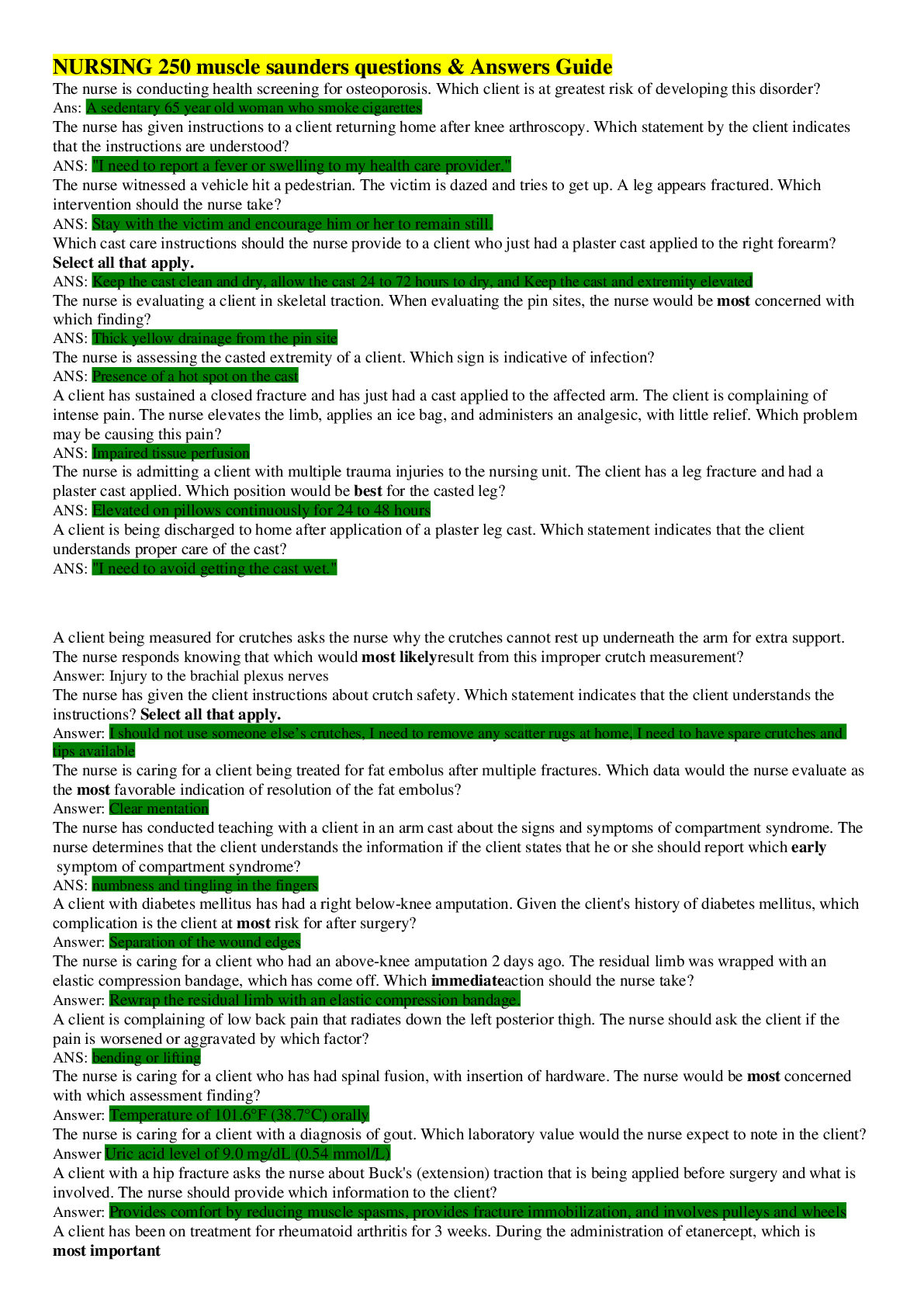
Buy this document to get the full access instantly
Instant Download Access after purchase
Add to cartInstant download
Reviews( 0 )
Document information
Connected school, study & course
About the document
Uploaded On
Nov 22, 2019
Number of pages
14
Written in
Additional information
This document has been written for:
Uploaded
Nov 22, 2019
Downloads
0
Views
89



